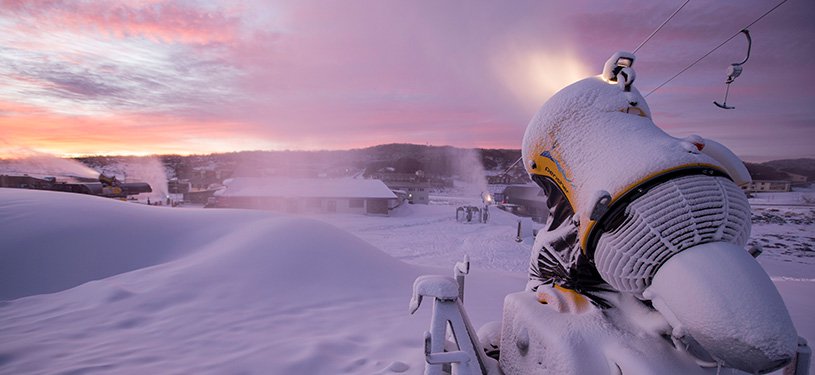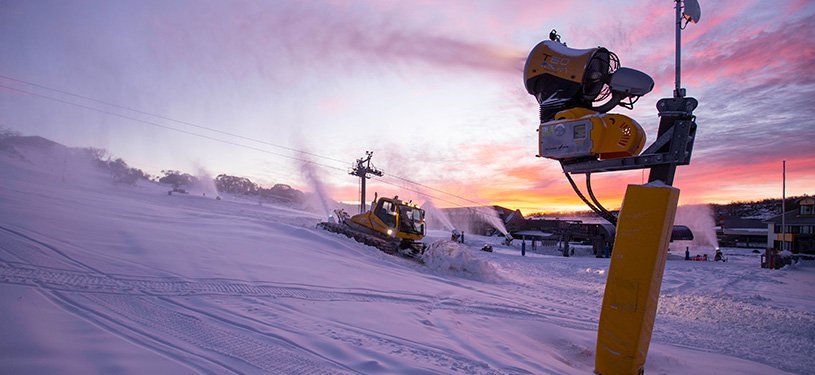Perisher has invested heavily in snowmaking to ensure guests are provided with the best possible conditions all winter. Since 2007, Perisher has spent over $22 million on improving and expanding the resort’s snowmaking system, including the installation of new automated, energy efficient snow-guns.
Techno Alpin has supplied the latest in automated snowmaking technology that is up to nine times more energy efficient than previous systems; improving snow reliability and quality. The new snow guns are controlled by computer software and have their air/water mix constantly adjusted to maximise efficiency under the prevailing climate conditions. The computer controlled automation also allows significantly quicker start-up and shut down than manual operations, further increasing efficiency.
Snowmaking covers 53.4 hectares across the resort. 236 snow-guns in the snowmaking inventory allow Perisher to produce snow across Front Valley; from Mid Station of the Perisher Quad Express through Yabby Flat and Goats Gully back to Front Valley, including lower Escapade and the PlayStation Slopestyle Park; Snowy Trails; Happy Valley; Towers Run and Tube Town at Perisher; the rope tow’s, carpets and Captain Cook J-bar at Smiggin Holes; Early Starter, Road Run to the Terminal Chairlift, Zali’s, The Pony Ride and Snowsports School Rope Tow, Road Run to Roller Coaster, Showboat and Excelerator runs at Blue Cow.
Perisher typically conducts extensive work over the summer months to create terrain that requires less snow to produce a safe and acceptable cover of snow for skiing and boarding. Examples of this work include summer grooming of the slopes, such as the removal of rocks and the erection of snow fences to help build up snow that can then be spread across the resort to locations which need additional cover.
Future plans to increase snowmaking at Perisher
Perisher plans to increase snowmaking coverage to 110 hectares, aiming to have all the trails linking the four ski areas covered from the seasons start to finish. All new snowmaking at Perisher will be automated to ensure that all snowmaking opportunities are maximised and that the snowmaking operation is as efficient as it can be. Perisher also plans to automate its existing snowmaking over time. The result – skiers and boarders will be able to ski to and from each of the four areas all season long!
How does snowmaking work?
To understand snowmaking, it is first necessary to understand what exactly snow is!
What is snow?
By definition, snow is ’crystallized ice particles having the physical integrity and the strength to maintain their shape’. Normally created by Mother Nature, but when Mother Nature does not deliver and snow is needed for ski resorts, that’s when the snowmakers step in to ensure visitors to the resort are able to enjoy on-snow activities.
Natural snow forms when water vapour in a cloud formation condenses into a raindrop. Given cold atmospheric conditions the raindrop freezes and forms an ice crystal with six tiny arms (called dendrites). This is the classic snowflake. On the other hand, man-made snow forms a compact six-sided structure more like an ice cube.
How does snowmaking make snow?
Simply put, snowmaking replicates nature by converting water into snow.
Snowmaking requires a significant level of infrastructure including water storages, pump stations, compressors, pipes, electricity supply, hydrants and weather stations. Snowmaking machines (commonly referred to as ‘snowguns’), make snow by breaking water into small particles, cooling the water by causing the particles to move through cold air, nucleating (the creation of small ice crystals) the particles and distributing the resulting snow on the ground.
The efficiency of snowmaking is largely driven by weather conditions. Low temperature and low humidity increase snowmaking efficiency, so in Australia, snowmaking is practicable mainly during the early to middle part of the season (typically May to mid-August).
Efficiency of snowmaking is enhanced by snowmaking additives, which are added to the stream of water to promote the nucleation of the snow. Scientific research both here and overseas shows the additives cause no environmental concern. The National Parks and Wildlife authorise additive use.

Water
Snowmaking ‘borrows’ water from the catchment and eventually returns it. The majority of the water used for Perisher’s snowmaking comes from a Snowy Hydro aqueduct. About 93% of the water used for the snowmaking is returned to the streams in the spring thaw starting in September. In many ways snowmaking stores water for the winter and returns it to the streams in the spring.
What is required for snowmaking?
An extensive system of steel piping is required to supply the snowmaking operation with compressed air and high-pressure water through separate pipes to the snowmaking hydrants on the slopes. A pumphouse at the end of the system produces the compressed air and has high-pressure pumps to supply the water.
Perisher has two plant rooms, one at Perisher’s Front Valley and one at the base of the Terminal Quad Chair at Blue Cow.
Snow Guns
Perisher uses three types of snow guns: manual air-water guns, fan guns and new fully automatic computer controlled snowmaking technology.
Manual air-water guns use a jet of compressed air from a central compressor to break up a stream of water into fine particles and propel these into the atmosphere under conditions which causes them to freeze as particles of snow. A snowmaker adjusts the amount of water to the snowgun to obtain the optimum snow quality.
Fan guns achieve a similar effect by passing a stream of water into an airflow produced by a fan; similarly water is adjusted to obtain the optimum snow quality.
While fans are slightly more energy-efficient than air-water guns, they produce snow in a broad dispersed band that’s difficult to direct, especially in windy conditions.
Air-water guns produce a more concentrated stream of snow, which can be more effectively directed along confined trails or accumulated in a large pile for distribution by grooming machines.
Both types of snow guns can be mounted on a tower to increase the amount of ‘hang time’ the water droplets are in the air, which increases the amount of snow that can be produced.
The new automated snowguns come in two types; Lances and Fans. Lances are similar to an air/water snowgun but are mounted on either a 6m or 9m tower and use 9 times less compressed air. Each gun is controlled by a computer system that constantly checks local weather information and adjusts the snowgun to produce the optimum snow quality. Automation also allows the snowmaking department to start and stop the snowguns quickly to take advantage of, sometimes, short snowmaking windows.

Snow Quality
The snowmaker determines snow quality. Snowmakers will make either wet, medium or dry snow depending on the condition of the ski slope and weather conditions. Adjustments of the snow guns, which are made every half to one hour throughout the night, allow optimum snow production for the prevailing weather conditions, including temperature, humidity, wind speed and direction.
While adjusting the snow gun, the snowmaker may make the quality of snow wetter or drier depending on what the ski slope needs. Increasing water flow to a gun will result in a wetter snow and alternatively, decreasing water flow will result in a drier snow.
Automation allows us to set the snow quality required from a snowgun, and the computer adjusts the snowgun constantly as the weather changes during the night.
For more information head to www.perisher.com.au
